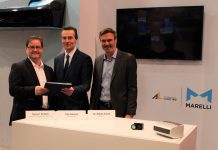Lumotive, startup developing LiDAR systems for autonomous vehicles, and Himax Display announced a first-of-its-kind, jointly-developed solution to enable disruptive beam steering technology in LiDAR systems that marries Himax’s proven Liquid-Crystal-On-Silicon (LCOS) technology with Lumotive’s patented Liquid Crystal Metasurfaces (LCMs) to significantly improve the performance, reliability and cost of LiDAR systems. In the automotive industry, Lumotive’s LiDAR solution will enable both advanced driver-assistance systems (or ADAS) and fully autonomous vehicles such as “robo-taxis” and self-driving trucks.
LiDAR, a key 3D-sensing technology for autonomous driving systems, requires advanced beam steering to deliver high performance and commercial viability. Traditionally, LiDAR relied on bulky spinning assemblies, while newer breeds of LiDAR sensors utilize MEMS mirrors or optical phased arrays. However, both of these approaches lack performance due to the small optical aperture of MEMS mirrors and the low efficiency of phased arrays. In a first for LiDAR, Lumotive leverages Himax’s unique, tailor-made LCOS process to convert semiconductor chips into dynamic displays that steer laser pulses based on the light-bending principles of metamaterials.
LiDAR and the Lumotive Advantage
LiDAR systems determine range by emitting laser light pulses and measuring the round-trip flight time for those pulses to travel to and reflect back from objects. A LiDAR system creates a 3D perceptual map, or “point cloud” of its surroundings by scanning, or “beam steering”, laser pulses across its two-dimensional field-of-view, with the third dimension derived from the distance measured to an object at a given horizontal and vertical position. LiDAR has proven critical for autonomous vehicles because the technology can accurately locate objects to within a few centimeters at ranges of hundreds of meters. LiDAR, which stands for Light Detection and Ranging, generally exhibits shorter range but superior measurement resolution compared to its older cousin, radar, which stands for Radio Detection and Ranging. Research firm Yole Développement estimates that the ADAS and autonomous vehicle LiDAR markets will grow dramatically in the coming years, increasing from $721 million in 2018 to $6.3 billion in 2024, with a CAGR of nearly 45% during that period.
Lumotive’s LCM chips contain no moving parts and are fabricated using mature semiconductor manufacturing processes and Himax’s tailor-made LCOS technology to enable commercially viable LiDAR systems with low cost, high reliability and small size. In addition to cost and performance advantages, Lumotive LCMs can be integrated into small form-factor systems, appealing for other applications in industrial and consumer sectors. Lumotive’s LiDAR systems offer dramatic performance advantages, including an unprecedented combination of:
- Large optical aperture (25 x 25 mm) which delivers long range
- 120-degree field-of-view with high angular resolution
- Fast, random-access beam steering














